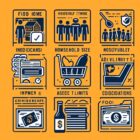Optimal Nutrition on a SNAP Budget

You might think that eating healthy on a limited budget is impossible, but think again. With the right knowledge and strategies, you can achieve optimal nutrition even on a SNAP budget.
Contrary to popular belief, healthy eating doesn’t have to break the bank. In this article, we will explore practical tips and evidence-based advice on how to plan a budget-friendly grocery list, maximize nutritional value with staple foods, incorporate affordable protein sources, and utilize smart shopping strategies.
Get ready to nourish your body without emptying your wallet.
Key Takeaways
- SNAP benefits have a positive effect on food security and reduce the risk of hunger and malnutrition.
- SNAP participants have lower rates of food insecurity compared to non-participants.
- SNAP improves dietary quality, with participants consuming more fruits, vegetables, whole grains, and dairy products.
- Staple foods like beans, whole grains, and vegetables are affordable, versatile, and nutrient-dense options for maximizing nutritional value on a SNAP budget.
Understanding SNAP Benefits
To understand the benefits of the Supplemental Nutrition Assistance Program (SNAP), you must first grasp its quantifiable impact on individuals and families.
SNAP is a federal program designed to assist low-income individuals and families in obtaining nutritious food. Research has shown that SNAP has a positive effect on food security, reducing the risk of hunger and malnutrition among its recipients. A study conducted by the United States Department of Agriculture (USDA) found that SNAP participants had significantly lower rates of food insecurity compared to non-participants. This means that SNAP helps ensure that individuals and families have access to enough food to lead active, healthy lives.
Furthermore, SNAP has been proven to improve dietary quality. According to a study published in the American Journal of Agricultural Economics, SNAP participants consumed more fruits, vegetables, whole grains, and dairy products than non-participants. This is significant because a healthy diet is crucial for overall well-being and can help prevent chronic diseases such as obesity, diabetes, and heart disease.
Understanding the impact of SNAP benefits is essential for planning a budget-friendly grocery list. By knowing the assistance SNAP provides, you can make informed decisions about the types of foods to prioritize and include in your shopping list.
Planning a Budget-Friendly Grocery List
When planning a budget-friendly grocery list on a SNAP budget, prioritize nutritious foods that align with the assistance provided by the program. This means focusing on nutrient-dense options such as fruits, vegetables, whole grains, lean proteins, and low-fat dairy products. These foods not only provide essential vitamins and minerals but also offer long-lasting energy and promote overall health.
To make the most of your SNAP benefits, it’s important to plan your meals and snacks in advance. This will help you avoid impulse purchases and ensure that you have a well-balanced diet throughout the week. Start by making a list of the foods you need and stick to it while shopping. Look for sales, discounts, and coupons to stretch your budget even further.
Consider buying fresh produce that’s in season as it tends to be more affordable. Frozen fruits and vegetables are also a great option, as they’re often cheaper and can be just as nutritious. Canned goods, such as beans, tomatoes, and fish, are budget-friendly and have a long shelf life. They can be used in a variety of dishes to add flavor and protein.
By planning your grocery list carefully, you can make the most of your SNAP benefits and ensure that you’re getting the nutrients your body needs.
Now let’s explore how to maximize the nutritional value of your meals using staple foods.
Maximizing Nutritional Value With Staple Foods
To maximize the nutritional value of your meals on a SNAP budget, it’s important to incorporate staple foods that provide essential nutrients and are cost-effective. Staple foods are affordable, versatile, and can form the foundation of a healthy diet. These foods are rich in nutrients and can be used in a variety of dishes to create satisfying and nourishing meals.
One staple food that’s both nutritious and budget-friendly is beans. Beans are high in protein, fiber, and essential minerals such as iron and magnesium. They’re also low in fat and cholesterol, making them a heart-healthy choice. Beans can be used in soups, stews, salads, and even as a meat substitute in dishes like chili or tacos.
Another staple food to consider is whole grains. Whole grains, such as brown rice, quinoa, and whole wheat pasta, are packed with fiber, vitamins, and minerals. They’re also more filling than refined grains, helping to keep you satisfied for longer. Whole grains can be used as a base for stir-fries, grain bowls, and side dishes.
Lastly, vegetables are an essential staple for maximizing nutritional value. Vegetables are low in calories and high in vitamins, minerals, and antioxidants. They can be enjoyed fresh, frozen, or canned, making them accessible year-round. Incorporating a variety of vegetables in your meals can help ensure you’re getting a wide range of nutrients.
Incorporating staple foods like beans, whole grains, and vegetables into your meals can maximize the nutritional value of your meals while staying within your SNAP budget. These foods are affordable, versatile, and nutrient-dense, making them an excellent choice for those looking to eat healthily on a limited budget.
Incorporating Affordable Protein Sources
By incorporating affordable protein sources, you can further enhance the nutritional value of your meals on a SNAP budget. Protein is an essential nutrient that plays a crucial role in building and repairing tissues, supporting immune function, and providing energy. Fortunately, there are several affordable protein options available that can help you meet your daily protein needs without breaking the bank.
Consider incorporating the following affordable protein sources into your meals:
- Beans and legumes: These aren’t only rich in protein but also high in fiber, vitamins, and minerals. They’re incredibly versatile and can be added to soups, stews, salads, and even made into burgers.
- Eggs: Eggs aren’t only an excellent source of protein but also contain essential vitamins and minerals. They’re affordable and can be used in various recipes, such as omelets, scrambled eggs, or hard-boiled eggs as a snack.
- Canned fish: Canned tuna, salmon, and sardines are affordable protein sources that are packed with omega-3 fatty acids and other nutrients. They can be used in sandwiches, salads, or mixed with pasta.
- Peanut butter: Peanut butter isn’t only delicious but also a great source of protein. Spread it on whole grain bread or use it as a dip for fruits and vegetables.
- Greek yogurt: Greek yogurt is higher in protein compared to regular yogurt. It can be enjoyed on its own or used as a base for smoothies, dips, or salad dressings.
Smart Shopping Strategies and Meal Prepping
To make the most of your SNAP budget and ensure optimal nutrition, it is important to regularly plan and prepare your meals in advance. Smart shopping strategies and meal prepping can help you stretch your dollars and make healthier choices. Here are some practical tips to help you navigate the grocery store and plan your meals effectively:
- Make a shopping list: Before heading to the store, create a list of the items you need. This will help you stay focused and avoid impulse purchases.
- Compare prices: Take the time to compare prices of different brands and products. Generic or store brands are often more affordable and offer similar nutritional value.
- Buy in bulk: Purchasing items in bulk can save you money in the long run. Look for staple foods like rice, beans, and oats that can be bought in larger quantities.
- Plan your meals: Plan your meals for the week based on the ingredients you already have and what’s on sale. This will help you avoid wasting food and ensure that you have nutritious meals ready to go.
Here is a table to help you plan your meals and make the most of your SNAP budget:
| Day | Breakfast | Lunch | Dinner |
|---|---|---|---|
| Monday | Oatmeal | Turkey sandwich | Chicken stir-fry |
| Tuesday | Yogurt with fruit | Salad with grilled | Spaghetti with |
| chicken | meat sauce | ||
| Wednesday | Scrambled eggs | Tuna salad | Vegetable curry |
| Thursday | Smoothie | Bean and cheese | Baked salmon with |
| quesadilla | roasted vegetables | ||
| Friday | Pancakes | Vegetable soup | Grilled chicken with |
| quinoa salad |
Frequently Asked Questions
Can I Use SNAP Benefits to Purchase Vitamins or Supplements?
Yes, you can use SNAP benefits to purchase vitamins or supplements. However, it’s important to remember that SNAP is primarily intended to help low-income individuals access food, so it’s recommended to prioritize nutritious food choices.
Are There Any Restrictions on the Types of Fruits and Vegetables I Can Buy With SNAP Benefits?
You can choose from a wide variety of fruits and vegetables with your SNAP benefits. There are no restrictions on the types you can buy, so go ahead and explore the bountiful options available to you!
Can SNAP Benefits Be Used to Purchase Organic or Specialty Foods?
Yes, SNAP benefits can be used to purchase organic or specialty foods. However, it is important to note that these options may be more expensive and could potentially limit the quantity of other nutritious foods you can purchase.
How Can I Ensure That I’m Getting Enough Essential Nutrients While on a SNAP Budget?
To ensure you’re getting enough essential nutrients on a SNAP budget, focus on nutrient-dense foods like fruits, vegetables, whole grains, and lean proteins. Plan meals, use coupons, buy in bulk, and compare prices to stretch your dollars.
Are There Any Resources or Programs Available to Help SNAP Recipients Learn About Nutrition and Meal Planning?
There are resources and programs available to help SNAP recipients learn about nutrition and meal planning. These can provide valuable information and support to ensure you make healthy choices on a limited budget.



